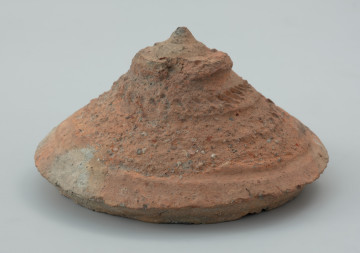
Clay lid
951 — 1200
National Museum in Szczecin
Part of the collection: Middle Ages
The production of pottery in the early Middle Ages was carried out mainly by highly-specialised potters. Their work started by obtaining the raw material, that met their requirements, from local quarries located in the immediate vicinity. This raw clay required a number of steps to get it ready, as a result of which it became a malleable mass, which could be used to make vessels of different sizes and functions. Ethnographic studies show that rural potters in Slavic lands had a tendency to mix lean clays with fat ones, while fat clays were often thinned by adding river sand or crushed pebbles. The vessel discovered in Kamień Pomorski was made of lean mass, enriched with an admixture of fine and medium-grained sand and granite. It was formed by rolling the vessel on a high-speed potter's wheel. It is characterised by its bulbous form with the edge of the spout pointing outwards. Its smooth surface is decorated with an ornament of slanted grooves, as well as straight and wavy lines around the vessel.
Grzegorz Durdyń
Author / creator
Dimensions
cały obiekt: height: 22.1 cm
Object type
vessel (container), culinary equipment
Technique
coating, roller technique, modelling
Material
clay
Origin / acquisition method
field research
Creation time / dating
Creation / finding place
Owner
Muzeum Narodowe w Szczecinie
Identification number
Location / status

951 — 1200
National Museum in Szczecin

476 — 1250
National Museum in Szczecin

801 — 1100
National Museum in Szczecin
DISCOVER this TOPIC
National Museum in Lublin
DISCOVER this PATH
Educational path